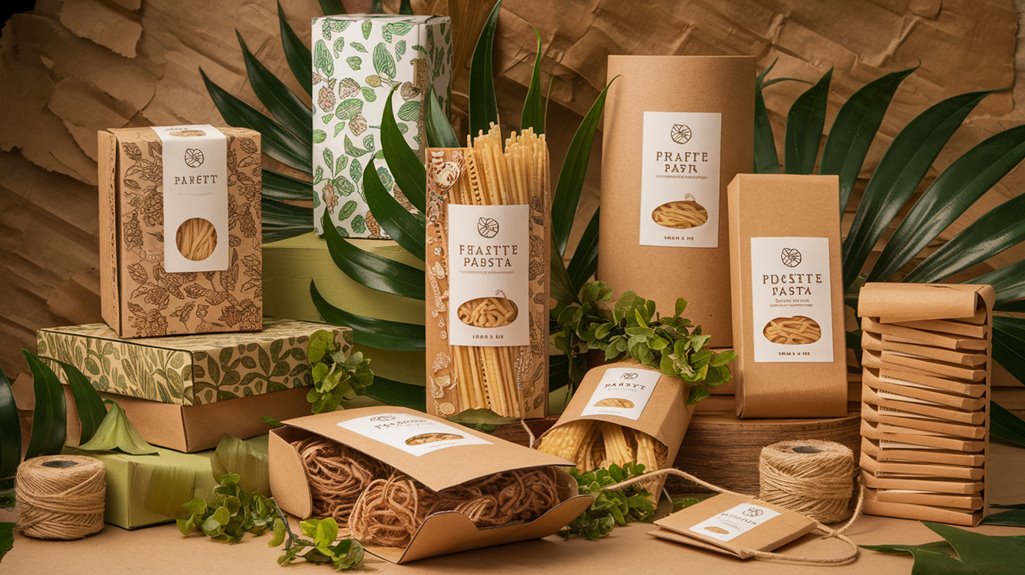
If you're looking to create eco-friendly pasta box packaging, consider using recycled cardboard, biodegradable papers, and plant-based inks. Recycled materials greatly reduce waste and comply with environmental regulations. Biodegradable options naturally break down within months, making them a smart choice for sustainability. Furthermore, using FSC-certified materials guarantees responsible sourcing. Lightweight designs can further minimize your environmental footprint. Remember, 75% of consumers prefer sustainable packaging, so choosing these materials not only benefits the planet but also boosts your brand's appeal. You'll discover even more valuable insights into sustainable packaging as you explore further.
Main Points
- Recycled cardboard is an ideal choice for pasta boxes, minimizing waste and ensuring full recyclability.
- Biodegradable papers offer freshness and break down naturally, reducing environmental impact.
- FSC-certified materials guarantee responsible sourcing and sustainability for packaging.
- Plant-based inks and adhesives enhance recyclability while maintaining visual appeal.
- Utilizing virgin cellulose fiber provides durability and strength while remaining eco-friendly.
Importance of Eco-Friendly Packaging
Eco-friendly packaging plays an important role in our fight against environmental degradation.
By utilizing sustainable materials and recycled materials, you can greatly reduce your product's environmental impact.
Compliance with environmental regulations not only guarantees food safety but also strengthens your brand reputation.
As consumer demand for eco-conscious products grows, adopting eco-friendly packaging becomes vital for attracting and retaining environmentally responsible shoppers. Additionally, using biodegradable materials can significantly enhance the sustainability of your packaging efforts.
Types of Sustainable Materials
Selecting the appropriate materials is key to creating sustainable pasta packaging that meets both environmental standards and consumer expectations.
You can opt for recycled materials, biodegradable plastics, and FSC-certified materials to minimize environmental impact.
Furthermore, using plant-based inks and adhesives enhances recyclability, while packaging made from virgin cellulose fiber guarantees durability.
Together, these choices promote effective, eco-friendly, compostable packaging solutions.
Benefits of Biodegradable Papers
While traditional packaging materials can linger in landfills for centuries, biodegradable papers offer a revitalizing alternative by breaking down naturally within months.
Made from renewable resources, these eco-friendly packaging options enhance product freshness while being environmentally responsible.
Recycled Cardboard Options
Recycled cardboard options provide an effective way to package pasta that benefits both the environment and your brand.
By using recycled cardboard, you address key environmental factors and improve your sustainability profile. This food-grade packaging material complies with regulations, protects against moisture and pests, and reduces packaging waste.
Plus, it's fully recyclable, making it a smart choice for eco-conscious consumers.
Plant-Based Plastics in Packaging
As the demand for sustainable packaging rises, plant-based plastics are emerging as a compelling alternative to traditional materials.
Derived from renewable resources, these biodegradable and compostable options markedly reduce the carbon footprint of food packaging.
With excellent moisture protection, they effectively safeguard products like pasta while minimizing environmental impact.
The growing market reflects your commitment to eco-friendly solutions in packaging.
Compostable Inks and Adhesives
When you choose packaging for your pasta products, considering compostable inks and adhesives can greatly enhance your eco-friendly efforts.
Compostable inks, derived from natural materials, guarantee packaging integrity while breaking down harmlessly. Compostable adhesives maintain sustainability, supporting a circular economy.
As consumer demand for sustainable packaging grows, your commitment to environmental responsibility will resonate with eco-conscious buyers, boosting your brand's appeal.
Lightweight Design Considerations
While aiming for sustainability, lightweight design in pasta packaging plays a crucial role in reducing transportation costs and carbon emissions.
By utilizing innovative packaging materials, like biodegradable composites, you enhance recyclability while ensuring moisture protection.
Striking the right balance between lightweight design and durability minimizes waste generation and supports environmental goals, making your pasta packaging both efficient and eco-friendly.
Consumer Trends in Packaging
Sustainability in packaging isn't just a trend; it's rapidly becoming a standard expectation among consumers.
With 75% preferring sustainable packaging options, many are willing to pay more for environmentally friendly packaging.
As concerns about plastic waste grow, 55% seek biodegradable or compostable materials.
Attractive packaging design also drives choices, with 70% influenced by how products look and function, shaping current consumer trends. Additionally, the rise in demand for eco-friendly materials indicates a shift towards more conscious consumer behavior.
Future of Sustainable Pasta Packaging
As the demand for eco-friendly solutions grows, the future of sustainable pasta packaging is set to transform the industry considerably.
You'll see a shift towards biodegradable and compostable materials, driven by consumer preferences. Companies are embracing recyclable materials and innovative packaging solutions, reducing environmental impact.
With regulations tightening, expect a rise in eco-friendly designs that prioritize sustainability in pasta packaging.
Conclusion
To sum up, embracing eco-friendly packaging for pasta boxes not only benefits the environment but also aligns with consumer values. By choosing sustainable materials like biodegradable papers, recycled cardboard, and plant-based plastics, you can contribute to a greener future. Plus, lightweight designs and compostable inks enhance the overall sustainability of your product. As the demand for eco-conscious packaging grows, staying ahead of the trend will set your brand apart and resonate with environmentally aware consumers.

